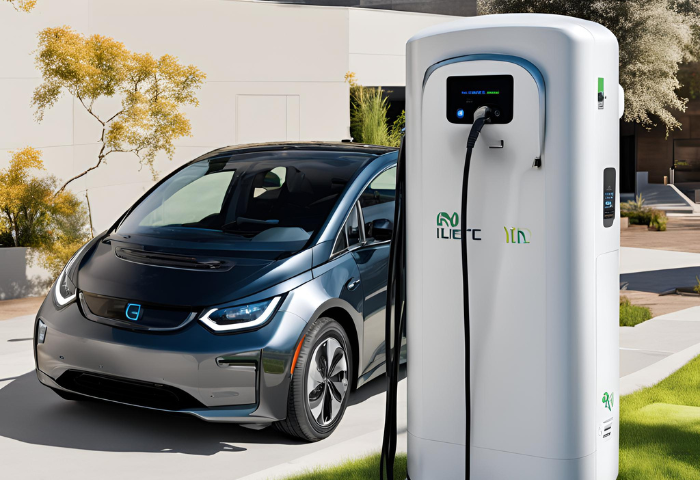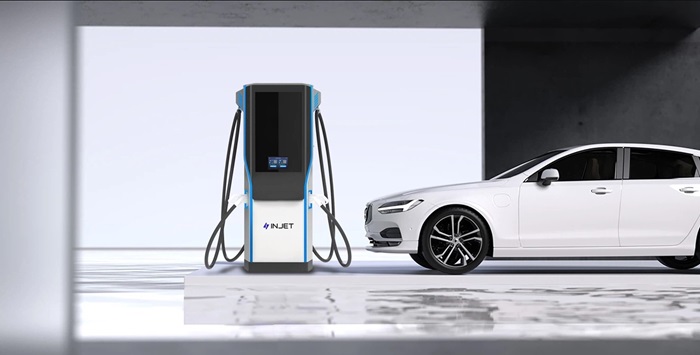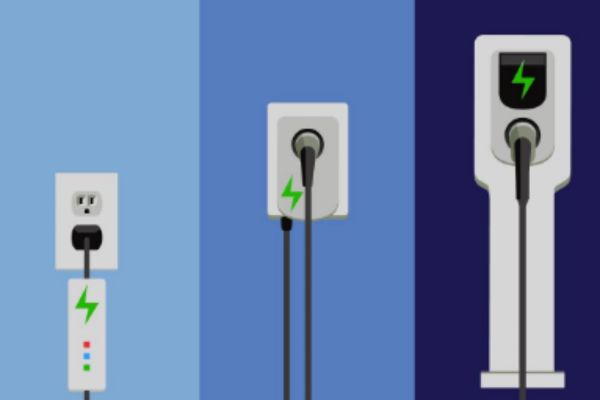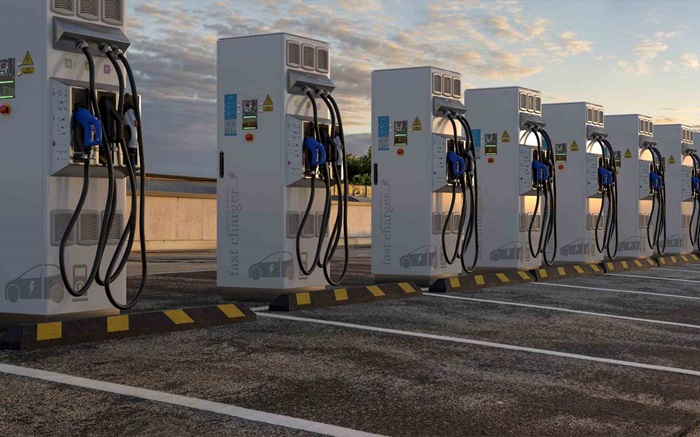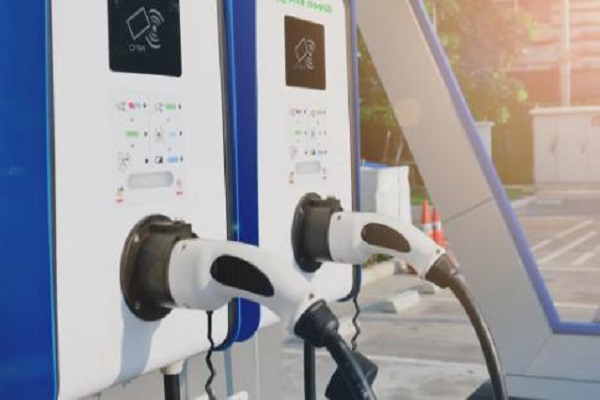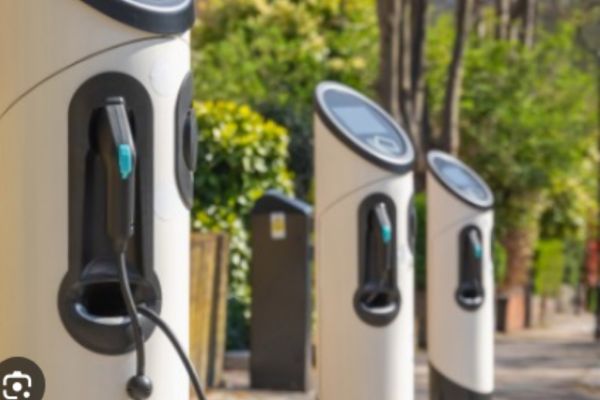Power on the Go: Exploring Mobile Level 3 EV Chargers
Mobile Level 3 EV chargers represent a groundbreaking solution for providing rapid charging capabilities to electric vehicles (EVs) in diverse locations, offering flexibility and convenience for EV drivers.
Mobile Level 3 EV Charger Overview
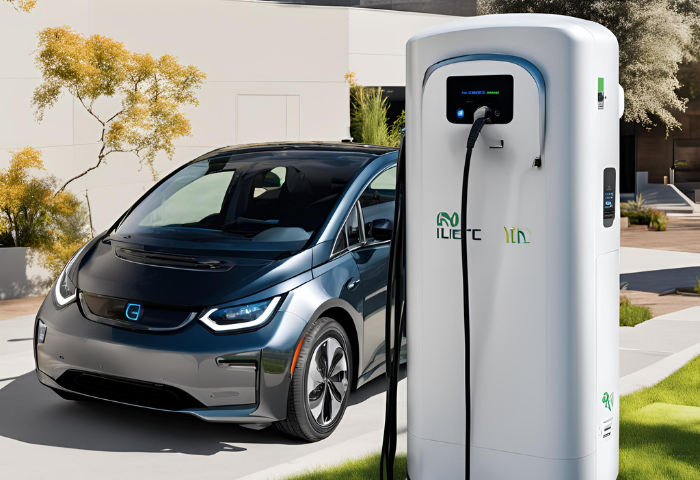
Definition and Technology Behind Level 3 Charging
| Aspect | Description |
| Definition | Level 3 charging, also known as DC fast charging, refers to the highest level of electric vehicle (EV) charging, delivering high-power direct current (DC) to the vehicle’s battery for rapid charging. It is characterized by its ability to charge EVs significantly faster than Level 1 and Level 2 charging. |
| Technology | Level 3 chargers use DC charging technology, which bypasses the vehicle’s onboard charger and delivers electricity directly to the battery at high voltage and current levels. This enables faster charging speeds, typically ranging from 50 kW to 350 kW or higher, depending on the charger’s specifications. |
| Connector Types | Level 3 chargers utilize various connector types, including CCS (Combined Charging System), CHAdeMO, and Tesla Supercharger, each compatible with different EV models and manufacturers. CCS and CHAdeMO are the most common connector types for Level 3 charging in North America, Europe, and Asia. |
| Charging Infrastructure | Level 3 chargers are typically installed in public locations such as highways, rest areas, shopping centers, and urban areas, where EV drivers can access fast charging services for long-distance travel or quick top-ups. Charging networks and service providers operate and maintain Level 3 charging infrastructure to support EV adoption and promote sustainable transportation. |
This table provides a structured overview of the definition and technology behind Level 3 charging, highlighting key aspects such as charging speed, connector types, and infrastructure deployment.
Differences Between Level 1, Level 2, and Level 3 Charging
| Aspect | Level 1 Charging | Level 2 Charging | Level 3 Charging (DC Fast Charging) |
| Voltage | 120 volts AC | 240 volts AC | Typically 200-600 volts DC |
| Amperage | Typically 12 amps | Typically 30 amps | Higher amperage, up to 400 amps |
| Power Output | Up to 1.4 kW | Up to 7.2 kW | 50 kW to 350 kW (or higher) |
| Typical Charging Time | 8-20 hours* | 4-8 hours* | 20-30 minutes (to 80% capacity)* |
| Connector | Standard household outlet (NEMA 5-15) | Dedicated charging station (J1772) | Specialized DC fast charging connector (e.g., CHAdeMO, CCS Combo, Tesla) |
| Use Cases | Overnight charging, occasional top-ups | Home, workplace, public charging | Long-distance travel, highway charging, rapid replenishment |
| Cost | Lower installation and equipment costs | Moderate installation and equipment costs | Higher installation and equipment costs; often pay-per-use or subscription-based |
*Charging times can vary depending on factors such as vehicle battery size, state of charge, and charger specifications.
Advantages of Mobile Level 3 EV Charging
Mobile Level 3 EV charging, also known as DC fast charging, offers several advantages, particularly in scenarios where stationary charging infrastructure may be limited or unavailable. Here are some key advantages:
Flexibility and Versatility:
Mobile Level 3 EV chargers can be deployed to any location where there is access to electricity, providing on-demand charging solutions in remote areas, during events, or in emergency situations. This flexibility enables EV drivers to charge their vehicles wherever they are, reducing range anxiety and increasing accessibility.
Rapid Charging Speeds:
Level 3 chargers deliver high-power DC charging, allowing EVs to charge at significantly faster rates compared to Level 1 and Level 2 chargers. This rapid charging capability reduces charging times, making it convenient for drivers who need to quickly top up their batteries during long trips or when time is limited.
Emergency Charging Services:
Mobile Level 3 EV chargers can serve as emergency charging solutions during power outages, natural disasters, or other unforeseen circumstances. They can be deployed to critical locations such as hospitals, evacuation centers, or disaster relief areas to provide essential electricity for EVs used in emergency response efforts.
Temporary Charging Solutions:
Mobile Level 3 chargers can be used as temporary charging solutions at events, festivals, construction sites, or other temporary locations where stationary charging infrastructure may not be practical or cost-effective. They provide a convenient and scalable option for providing EV charging services on a short-term basis.
Infrastructure Expansion:
Mobile Level 3 EV charging can support the expansion of charging infrastructure by providing interim solutions while permanent charging stations are being planned, permitted, or constructed. This allows for more rapid deployment of charging infrastructure, particularly in areas where infrastructure development may be challenging or time-consuming.
Cost-Effective Deployment:
Mobile Level 3 chargers can be deployed temporarily or moved to different locations as needed, reducing the upfront costs associated with installing permanent charging infrastructure. This makes them a cost-effective option for providing EV charging services in areas with fluctuating demand or limited resources.
Promotes EV Adoption:
By increasing the availability and accessibility of fast charging options, mobile Level 3 EV chargers help promote the adoption of electric vehicles. They address barriers to EV ownership such as range anxiety and limited charging infrastructure, making EVs more viable for a wider range of drivers.
Key Market Players and Manufacturers
Key market players and manufacturers in the electric vehicle (EV) charging sector encompass a range of companies specializing in hardware, software, and infrastructure development. Here are some prominent ones:
Tesla: Known for its Supercharger network, Tesla is a major player in the EV charging market. Their Supercharger stations offer high-speed charging for Tesla vehicles, primarily along major travel routes.
Electrify America: Established as part of the Volkswagen diesel emissions settlement, Electrify America is one of the largest open DC fast-charging networks in the United States. They focus on deploying fast-charging infrastructure to support various EV models.
EVgo: EVgo operates one of the largest public fast-charging networks in the U.S., with a focus on urban areas and major highways. They provide both Level 2 and DC fast charging solutions.
ChargePoint: ChargePoint offers a comprehensive network of EV charging stations, including Level 2 AC charging stations for home, workplace, and public locations, as well as DC fast chargers.
ABB: ABB is a multinational corporation specializing in robotics, power, and automation technology. They provide a range of EV charging solutions, including fast-charging hardware and software for the public and private sectors.
Siemens: Siemens offers EV charging infrastructure solutions, including hardware, software, and integration services for public, fleet, and residential applications.
Delta Electronics: Delta Electronics manufactures EV charging stations and solutions for various applications, including residential, commercial, and public charging.
Tritium: Tritium is an Australian company known for its high-power DC fast-charging solutions. They provide charging hardware for various applications, including highway charging stations and urban hubs.
BTC Power: BTC Power designs and manufactures EV charging hardware, including DC fast-charging solutions for public and private use. They offer a range of power levels to accommodate different EV charging needs.
Typical Use Cases and Applications
| Use Case | Description |
| Residential Charging | Home charging stations allow EV owners to conveniently charge their vehicles overnight, providing a full battery by morning. It’s ideal for daily commuting and ensures the EV is ready for daily use. |
| Workplace Charging | Charging stations installed at workplaces enable employees to charge their EVs during the workday, promoting EV adoption, supporting sustainability initiatives, and attracting environmentally-conscious employees. |
| Public Charging | Public charging stations, located in commercial areas, parking lots, and along highways, provide on-the-go charging options for EV drivers, facilitating longer trips and addressing range anxiety. |
| Fleet Charging | Fleet operators, such as taxi companies, delivery services, and municipalities, install charging infrastructure to support large numbers of EVs, reducing operational costs, emissions, and reliance on fossil fuels. |
| Destination Charging | Hotels, restaurants, shopping centers, and tourist attractions offer destination charging to attract EV-driving customers, increase foot traffic, and enhance customer satisfaction with added amenities. |
| Fast Charging | High-power fast charging stations, strategically located along highways and major travel routes, enable rapid charging for long-distance travel, reducing charging stops and promoting EV adoption for intercity travel. |
| Emergency and Backup Charging | EV charging infrastructure can serve as emergency backup power sources during power outages or grid disruptions, providing critical electricity for emergency services, hospitals, and essential facilities. |
| Community Charging | Community charging programs, such as shared neighborhood charging hubs or cooperative charging networks, foster collaboration, resource-sharing, and EV adoption within local communities. |
| Event and Temporary Charging | Temporary charging solutions, deployed at events, festivals, or construction sites, offer convenient charging options for attendees, workers, and temporary residents, supporting sustainable event management practices. |
| Off-Grid and Remote Charging | Off-grid and remote charging solutions, powered by renewable energy sources such as solar or wind, enable EV charging in areas without access to traditional grid infrastructure, promoting energy independence and sustainability. |
By considering these use cases and applications, stakeholders can design and deploy EV charging infrastructure tailored to specific needs, locations, and user requirements, supporting the transition to electric mobility and advancing sustainability goals.
Specification and Requirements for Mobile Level 3 EV Chargers

Power Output and Charging Speed
| Consideration | Description |
| Power Output | Power output refers to the maximum amount of electrical power that a charging station can deliver to an electric vehicle (EV) battery during a charging session, typically measured in kilowatts (kW). |
| Charging Speed | Charging speed is the rate at which an EV battery can be charged, expressed in terms of miles of range gained per hour (mph) or percentage of battery capacity per hour (%/hour). |
| AC vs. DC Charging | AC (alternating current) charging typically delivers power at lower rates (up to 22 kW), suitable for slower overnight charging at home or workplace. DC (direct current) charging offers higher power output (up to 350 kW), enabling rapid charging at public fast charging stations. |
| Level 1, Level 2, Level 3 Charging | Level 1 charging operates on standard household AC outlets, providing low power output (up to 2.4 kW). Level 2 charging utilizes dedicated EV charging stations with higher power output (up to 22 kW), suitable for home, workplace, and public charging. Level 3 charging, also known as DC fast charging or ultra-fast charging, delivers the highest power output (up to 350 kW), enabling rapid charging for long-distance travel and commercial applications. |
| Charging Curve | Charging speed may vary over the course of a charging session due to factors such as battery state of charge (SoC), temperature, and charging protocol limitations. Charging curves illustrate the relationship between charging power and battery SoC, helping users understand expected charging times and efficiency. |
| Compatibility with EV Models | Charging speed capabilities may vary depending on the EV model, battery chemistry, and onboard charging hardware. Compatibility with different charging protocols (e.g., CCS, CHAdeMO, Type 2) and power levels ensures interoperability and flexibility for EV drivers. |
| Impact on User Experience | Faster charging speeds offer greater convenience and flexibility for EV drivers, reducing wait times and enabling longer trips without extended stops. High-power charging infrastructure supports the adoption of electric vehicles by addressing range anxiety and improving the overall driving experience. |
By considering power output and charging speed considerations, stakeholders can design and deploy EV charging infrastructure that meets the needs of diverse EV drivers, enhances user experience, and accelerates the transition to electric mobility.
Physical and Electrical Requirements
| Aspect | Level 1 Charging | Level 2 Charging | Level 3 Charging (DC Fast Charging) |
| Physical Requirements | – Standard household outlet (NEMA 5-15)- Portable charger- No additional installation required beyond outlet | – Dedicated charging station- Wall-mounted or pedestal-mounted- Installation required, including mounting, signage, and accessibility considerations | – Dedicated charging station- Typically larger and more complex- Installation required at dedicated charging stations |
| Electrical | 120 volts AC | 240 volts AC | Typically 200-600 volts DC |
| Requirements | – Up to 1.4 kW- Requires standard electrical circuit- Minimal electrical upgrades necessary | – Up to 3.3 kW to 19.2 kW- Requires dedicated circuit with appropriate voltage and amperage- Electrical upgrades may be necessary, including panel and wiring upgrades | – 50 kW to 350 kW or higher- Requires robust electrical infrastructure capable of supplying high-voltage DC power- Extensive electrical upgrades may be required, including transformer installations and grid connections |
This table provides a concise comparison of the physical and electrical requirements for Level 1, Level 2, and Level 3 EV charging, highlighting differences in outlet types, installation complexity, voltage, power output, and necessary electrical upgrades.
Compatibility with Vehicle Models
| Aspect | Level 1 Charging | Level 2 Charging | Level 3 Charging (DC Fast Charging) |
| Compatibility | Compatible with all EV models that support Level 1 charging | Compatible with most EV models that support Level 2 charging | Compatible with EV models equipped with fast-charging capabilities |
| Commonly used for plug-in hybrids and low-range EVs due to slower charging speed | Widely used for various EV models, including plug-in hybrids and all-electric vehicles | Primarily used for long-range EVs and EVs intended for long-distance travel | |
| Limited suitability for long-distance travel due to slow charging speed | Suitable for daily charging needs and occasional longer trips | Ideal for long-distance travel and quick charging needs | |
| Often used for overnight charging or occasional top-ups | Commonly installed in homes, workplaces, and public locations | Found along highways, major travel routes, and commercial areas |
This table provides an overview of the compatibility of different charging levels with various types of electric vehicle models, highlighting their suitability for different charging scenarios and travel requirements.
Port Types and Connectivity
| Aspect | Level 1 Charging | Level 2 Charging | Level 3 Charging (DC Fast Charging) |
| Port Type | Standard household outlet (NEMA 5-15) | J1772 connector | CHAdeMO, CCS Combo, Tesla connector |
| (or equivalent) | (varies by manufacturer) | ||
| Connectivity | Plug-and-play | Plug-and-play | Specific fast-charging connector |
| No special connector required | J1772 connector is standard for Level 2 chargers | Different connectors for different charging standards | |
| Compatible with all EVs using standard outlets | Compatible with most EVs using J1772 standard | Compatibility varies depending on EV manufacturer and connector type | |
| Limited to Level 1 charging capability | Offers Level 1 and Level 2 charging capability | Offers Level 1, Level 2, and Level 3 charging capability | |
| High-power connector enables rapid charging |
This table provides an overview of the port types and connectivity associated with each charging level, highlighting the differences in connectors and compatibility with electric vehicle models.
Safety Standards and Certifications
| Aspect | Level 1 Charging | Level 2 Charging | Level 3 Charging (DC Fast Charging) |
| Safety Standards | UL 2231 | UL 2231 | UL 2202, IEC 61851, ISO 15118, SAE J1772, CHAdeMO, CCS Combo |
| ANSI C63.10, ANSI C136.41, NEC Article 625, IEEE 1547.1, IEEE 1547.8 | |||
| UL 2202 (for charger components) | |||
| Certifications | UL Listed | UL Listed | UL Listed (for charger components) |
| ETL Listed | ETL Listed | CHAdeMO Certified, CCS Certified, | |
| Tesla Supercharger Certified |
This table provides an overview of the safety standards and certifications associated with each charging level, highlighting the importance of meeting regulatory requirements and industry standards to ensure the safety and reliability of electric vehicle charging infrastructure.
Installation and Operation of Mobile Level 3 EV Chargers
Site Selection and Infrastructure Considerations
Here’s a structured representation of site selection and infrastructure considerations for electric vehicle (EV) charging infrastructure:
| Consideration | Description |
| Location | Choose sites strategically located near high-traffic areas, commercial centers, workplaces, and residential areas to maximize accessibility and user convenience. |
| Proximity to Power Sources | Select sites with access to reliable and sufficient electrical power sources, such as grid connections or renewable energy installations, to support charging infrastructure. |
| Parking Layout | Assess parking layouts and configurations to determine optimal placement and distribution of charging stations, ensuring convenient access and efficient use of parking spaces. |
| Zoning Regulations | Review zoning regulations, land use policies, and permitting requirements to identify suitable locations for installing charging infrastructure and ensure compliance with local laws. |
| Environmental Impact | Evaluate the environmental impact of charging infrastructure deployments, considering factors such as air quality, noise levels, visual impact, and ecological sensitivity. |
| Grid Capacity and Upgrades | Assess the capacity of the electrical grid and evaluate the need for upgrades or reinforcements to support additional charging loads, minimizing strain on the grid infrastructure. |
| Accessibility and ADA Compliance | Ensure accessibility and compliance with the Americans with Disabilities Act (ADA) standards by providing designated accessible parking spaces and charging stations for users with disabilities. |
| Security and Safety | Address security and safety concerns by selecting well-lit, secure locations with surveillance cameras, emergency call boxes, and measures to prevent vandalism and theft of charging equipment. |
| Network Coverage | Consider network coverage and connectivity options for remote monitoring, management, and payment processing, ensuring reliable communication between charging stations and backend systems. |
| Future Expansion Plans | Plan for future expansion and scalability of charging infrastructure by selecting sites with space for additional stations and infrastructure upgrades to accommodate growing demand. |
| Customer Amenities | Enhance user experience by providing amenities such as restrooms, seating areas, Wi-Fi access, and nearby retail or dining options to attract and retain EV drivers at charging locations. |
By considering these site selection and infrastructure considerations, stakeholders can identify suitable locations, mitigate potential challenges, and optimize the deployment of EV charging infrastructure to meet the needs of users and support the growth of electric mobility.
Installation Process and Guidelines
Here’s a structured guide for the installation process and guidelines for electric vehicle (EV) charging stations:
Installation Process:
Site Assessment: Evaluate the proposed site for suitability, considering factors such as accessibility, power supply, space requirements, and environmental impact.
Permitting and Approvals: Obtain necessary permits and approvals from local authorities, including zoning permits, building permits, and environmental assessments.
Electrical Infrastructure: Install or upgrade electrical infrastructure to support the charging stations, including transformers, distribution panels, and wiring to connect to the grid.
Charging Equipment Installation: Install the charging equipment according to manufacturer specifications, including mounting, wiring, and connection to the electrical supply.
Network Connectivity: Set up network connectivity for monitoring and management of charging stations, including internet connectivity and backend software integration.
Safety Measures: Implement safety measures such as signage, markings, and barriers to ensure user safety and compliance with regulations.
Testing and Commissioning: Test the charging equipment to ensure proper functionality and compatibility with EVs. Commission the charging stations for operation.
Training and Education: Provide training to staff and users on how to use the charging stations safely and efficiently. Educate users on charging etiquette and best practices.
Launch and Promotion: Launch the charging stations with appropriate promotion and awareness campaigns to attract users and encourage EV adoption.
Guidelines:
Compliance: Ensure compliance with local building codes, zoning regulations, and electrical standards for the installation of charging stations.
Accessibility: Design charging stations to be accessible to all users, including those with disabilities, by providing designated parking spaces and compliant infrastructure.
Safety: Prioritize safety in the installation process, including proper grounding, electrical insulation, and adherence to safety protocols during installation and operation.
Scalability: Design charging infrastructure with scalability in mind to accommodate future growth in EV adoption. Plan for expansion and additional charging stations as demand increases.
Integration: Integrate charging stations with existing infrastructure such as lighting, signage, and surveillance systems. Ensure compatibility and seamless integration with backend software systems.
Maintenance: Develop a maintenance plan to regularly inspect, maintain, and repair charging equipment to ensure optimal performance and reliability.
User Experience: Prioritize user experience in the design and installation of charging stations, including ease of use, accessibility, and amenities for EV drivers.
User Interface and Charging Process
User interface and the charging process are critical aspects of electric vehicle (EV) charging infrastructure, influencing user experience, accessibility, and satisfaction. Here’s a structured representation of user interface and charging process considerations for EV charging infrastructure:
| Aspect | Description |
| User-Friendly Interface | Development of an intuitive and user-friendly interface for charging stations, mobile applications, and web portals, facilitating easy navigation, operation, and access to charging services. |
| Charging Station Display | Provision of clear and informative displays on charging stations, featuring charging status indicators, instructions, pricing information, and contact details for support and assistance. |
| Mobile App Integration | Integration of mobile applications for EV charging, allowing users to locate nearby charging stations, initiate and monitor charging sessions, make payments, and receive notifications on their smartphones. |
| Payment Options | Support for multiple payment options, including credit/debit cards, mobile wallets, RFID cards, and subscription services, to accommodate diverse user preferences and facilitate seamless transactions. |
| User Authentication Methods | Implementation of user authentication methods, such as RFID cards, mobile app logins, QR codes, and biometric authentication, to ensure secure access to charging stations and prevent unauthorized use. |
| Plug-and-Charge Compatibility | Adoption of plug-and-charge technology, allowing EVs equipped with compatible communication protocols to automatically authenticate and initiate charging without the need for additional user input. |
| Charging Session Management | Provision of features for managing charging sessions, including start/stop controls, session scheduling, energy consumption tracking, and historical usage data, enhancing user control and transparency. |
| Real-Time Status Updates | Real-time updates on charging station availability, occupancy, and status, displayed on mobile apps, websites, and navigation systems, to help users find and select available charging stations. |
| Charging Rate Selection | Ability for users to select charging rates or power levels based on their preferences, vehicle compatibility, charging time constraints, and cost considerations, optimizing charging efficiency and flexibility. |
| Charging Notifications | Delivery of charging notifications and alerts via mobile apps, SMS, or email, informing users of session progress, completion, billing summaries, and any relevant updates or issues requiring attention. |
| Accessibility Features | Integration of accessibility features, such as audio prompts, tactile buttons, braille labels, and wheelchair-friendly design, to ensure equitable access to charging stations for users with disabilities. |
| Multi-Language Support | Support for multi-language interfaces and instructions on charging stations and mobile apps, catering to users from diverse linguistic backgrounds and enhancing accessibility and inclusivity. |
By addressing these user interface and charging process aspects, charging infrastructure operators can enhance user satisfaction, accessibility, and convenience, driving greater adoption of electric vehicles and promoting sustainable mobility.
Maintenance and Troubleshooting
Maintenance and troubleshooting are crucial aspects of ensuring the reliable operation and performance of electric vehicle (EV) charging infrastructure. Here’s a structured representation of maintenance and troubleshooting considerations for EV charging infrastructure:
| Aspect | Description |
| Preventive Maintenance | Implementation of preventive maintenance schedules and procedures to regularly inspect, clean, and service charging equipment, minimizing the risk of unexpected failures and downtime. |
| Routine Inspections | Conducting routine inspections of charging stations, electrical components, connectors, cables, and mounting hardware to identify signs of wear, damage, or degradation and address issues promptly. |
| Equipment Calibration | Calibration of charging equipment, sensors, meters, and communication interfaces to ensure accurate performance, measurement, and billing, maintaining customer trust and satisfaction. |
| Component Replacement | Replacement of worn-out or damaged components, such as cables, connectors, plugs, and contactors, with new or refurbished parts to maintain optimal charging performance and safety. |
| Troubleshooting Procedures | Development of troubleshooting procedures, diagnostic tests, and error code interpretations to identify and resolve common issues, minimize downtime, and restore charging functionality quickly. |
| On-Site Support and Repair | Provision of on-site support and repair services by trained technicians or service personnel to address complex issues, hardware failures, or critical system faults requiring immediate attention. |
| Remote Diagnostics and Support | Utilization of remote diagnostics and support tools to troubleshoot charging station issues, diagnose faults, and provide guidance or instructions for resolution without physical intervention. |
| Spare Parts Inventory Management | Maintenance of a spare parts inventory with critical components, consumables, and replacement items to facilitate rapid repairs, minimize downtime, and ensure uninterrupted operation of charging infrastructure. |
| Service Level Agreements (SLAs) | Establishment of service level agreements (SLAs) with equipment manufacturers, service providers, or maintenance contractors to define response times, resolution targets, and performance metrics for maintenance and support. |
| Data Analytics for Performance | Analysis of maintenance data, performance metrics, and fault logs using data analytics tools to identify trends, patterns, and recurring issues, informing proactive maintenance strategies and equipment improvements. |
| Continuous Improvement Practices | Implementation of continuous improvement practices, such as root cause analysis, lessons learned, and feedback mechanisms, to identify opportunities for process optimization, quality enhancement, and customer satisfaction improvement. |
By addressing these maintenance and troubleshooting aspects, operators can ensure the reliability, safety, and performance of EV charging infrastructure, minimize downtime, and provide a seamless charging experience for EV users.
Remote Monitoring and Firmware Updates
Remote monitoring and firmware updates are essential features of electric vehicle (EV) charging infrastructure, enabling efficient management, maintenance, and optimization of charging stations. Here’s a structured representation of remote monitoring and firmware updates for EV charging infrastructure:
| Aspect | Description |
| Remote Monitoring System | Implementation of a remote monitoring system for real-time monitoring and management of charging infrastructure, allowing operators to track station status, usage data, and performance metrics remotely. |
| Monitoring Dashboard | Deployment of a centralized monitoring dashboard or software platform for monitoring multiple charging stations, providing operators with a comprehensive overview of network health, status alerts, and analytics. |
| Connectivity Options | Support for various connectivity options, including Ethernet, Wi-Fi, cellular, and Zigbee, to ensure reliable communication between charging stations, backend systems, and remote monitoring platforms. |
| Diagnostic Alerts and Notifications | Generation of diagnostic alerts and notifications for charging station faults, errors, or anomalies, allowing operators to proactively identify and address issues to minimize downtime and service disruptions. |
| Performance Analytics | Analysis of charging station performance data, including session history, charging rates, energy consumption, and revenue generation, to optimize station utilization, pricing strategies, and network efficiency. |
| Predictive Maintenance | Implementation of predictive maintenance algorithms and analytics to anticipate equipment failures, schedule proactive maintenance, and extend the lifespan of charging infrastructure components, reducing repair costs and downtime. |
| Firmware Over-the-Air (OTA) Updates | Support for firmware over-the-air (OTA) updates for charging station software, enabling remote deployment of software patches, bug fixes, feature enhancements, and security updates without physical access to the equipment. |
| Security and Authentication | Integration of robust security protocols, encryption mechanisms, and user authentication methods to ensure the confidentiality, integrity, and authenticity of data transmitted between charging stations and backend systems. |
| Compliance with Regulatory Standards | Adherence to regulatory standards and requirements for remote monitoring systems, firmware updates, and data privacy, ensuring compliance with industry regulations, cybersecurity standards, and customer privacy laws. |
| User Interface and Accessibility | Development of user-friendly interfaces and mobile applications for remote monitoring and management, allowing operators to access charging station data, configure settings, and perform firmware updates from any location. |
By incorporating these features into EV charging infrastructure deployments, operators can streamline operations, improve reliability, and enhance user experience while ensuring compliance with regulatory standards and cybersecurity requirements.
Environmental Impact and Sustainability
Energy Efficiency and Renewable Energy Integration
Energy efficiency and renewable energy integration are key considerations in the design and operation of electric vehicle (EV) charging infrastructure, aiming to maximize sustainability and minimize environmental impact. Here’s a structured representation of energy efficiency and renewable energy integration for EV charging infrastructure:
| Aspect | Description |
| Energy Efficiency Measures | Implementation of energy-efficient charging equipment, including high-efficiency power conversion systems, smart charging algorithms, and energy-saving features to minimize energy losses and maximize charging efficiency. |
| Idle Power Consumption Reduction | Reduction of idle power consumption during standby or inactive periods by implementing power management strategies and standby modes, reducing energy waste and operating costs. |
| Power Factor Optimization | Optimization of power factor correction in charging equipment to improve power quality, reduce reactive power losses, and enhance energy efficiency, especially in high-power charging installations. |
| Load Management Strategies | Implementation of load management strategies, such as demand response, load shedding, and peak shaving, to optimize charging schedules, minimize grid stress, and reduce energy costs during peak demand periods. |
| Renewable Energy Procurement | Procurement of renewable energy from sources such as solar, wind, and hydroelectric power to power EV charging infrastructure, reducing reliance on fossil fuels and minimizing carbon emissions. |
| On-Site Renewable Energy Generation | Integration of on-site renewable energy generation systems, such as solar photovoltaic (PV) panels and wind turbines, into charging infrastructure installations to generate clean energy locally and offset grid electricity consumption. |
| Energy Storage Integration | Integration of energy storage systems, such as batteries or ultracapacitors, into EV charging infrastructure to store surplus renewable energy and provide peak shaving capabilities, improving grid stability and energy efficiency. |
| Vehicle-to-Grid (V2G) Integration | Implementation of vehicle-to-grid (V2G) technologies, enabling bidirectional energy flow between EVs and the grid, to support grid balancing, demand response, and energy arbitrage, maximizing renewable energy utilization and grid stability. |
| Microgrid and Islanding Capabilities | Development of microgrid capabilities and islanding functionality in EV charging infrastructure installations, allowing them to operate independently or in conjunction with the main grid during grid outages or emergencies, enhancing resilience and reliability. |
| Green Building and Certification | Designing EV charging infrastructure projects to meet green building standards and certifications, such as LEED (Leadership in Energy and Environmental Design) and Net Zero Energy, to demonstrate environmental sustainability and energy efficiency. |
| Energy Monitoring and Reporting | Installation of energy monitoring and reporting systems to track energy consumption, renewable energy generation, and carbon emissions associated with EV charging infrastructure operations, enabling performance optimization and reporting on sustainability metrics. |
By addressing these aspects, stakeholders can enhance the energy efficiency, sustainability, and environmental performance of EV charging infrastructure, contributing to the transition towards a low-carbon and renewable energy-powered transportation system.
Carbon Footprint and Emission Reductions
Carbon footprint and emission reductions are critical considerations in the evaluation of electric vehicle (EV) charging infrastructure, aiming to minimize greenhouse gas emissions and mitigate climate change. Here’s a structured representation of carbon footprint and emission reductions associated with EV charging infrastructure:
| Aspect | Description |
| Carbon Footprint Analysis | Assessment of the total greenhouse gas emissions, including carbon dioxide (CO2), methane (CH4), and nitrous oxide (N2O), associated with EV charging infrastructure throughout its life cycle. |
| Scope of Emissions | Identification of direct and indirect emissions sources, including energy consumption, manufacturing processes, transportation, and end-of-life disposal, across the entire life cycle of charging infrastructure. |
| Grid Emissions Intensity | Analysis of the carbon intensity of electricity generation sources used to power EV charging infrastructure, considering the mix of renewable energy, fossil fuels, and nuclear power in the grid. |
| Emission Reduction Strategies | Implementation of strategies to reduce emissions associated with charging infrastructure, such as transitioning to renewable energy sources, improving energy efficiency, and optimizing operational practices. |
| Vehicle Emissions Offsetting | Offsetting of emissions from charging infrastructure by encouraging EV adoption and promoting the use of zero-emission vehicles powered by renewable energy, thereby reducing overall transportation-related emissions. |
| Life Cycle Assessment | Conducting a life cycle assessment (LCA) to quantify the environmental impacts, including carbon emissions, associated with EV charging infrastructure from raw material extraction to end-of-life disposal. |
| Renewable Energy Integration | Integration of renewable energy sources, such as solar, wind, and hydroelectric power, into EV charging infrastructure to minimize reliance on fossil fuels and reduce carbon emissions. |
| Grid-Interactive Charging | Implementation of grid-interactive charging strategies, such as smart charging, vehicle-to-grid (V2G) integration, and demand response, to optimize charging schedules and minimize peak demand, reducing emissions and grid stress. |
| Environmental Certifications | Pursuit of environmental certifications, such as LEED (Leadership in Energy and Environmental Design) and ISO 14001, for EV charging infrastructure projects to demonstrate commitment to sustainability and emissions reduction. |
| Carbon Accounting and Reporting | Tracking and reporting of carbon emissions associated with EV charging infrastructure operations, manufacturing, and supply chain activities to assess progress towards emissions reduction targets and compliance with regulations. |
| Public Awareness and Education | Awareness campaigns and educational initiatives to inform stakeholders, including EV owners, policymakers, and the general public, about the carbon footprint of transportation and the benefits of EV adoption for emissions reduction. |
By addressing these aspects, stakeholders can effectively quantify, mitigate, and reduce the carbon footprint of EV charging infrastructure, contributing to the transition towards a low-carbon and sustainable transportation system.
Life Cycle Assessment
Life cycle assessment (LCA) is a systematic approach used to evaluate the environmental impacts associated with all stages of a product’s life cycle, from raw material extraction and manufacturing to distribution, use, and end-of-life disposal or recycling. Here’s a structured representation of life cycle assessment considerations for electric vehicle (EV) charging infrastructure:
| Aspect | Description |
| Raw Material Extraction | Evaluation of environmental impacts associated with extracting raw materials, such as metals, plastics, and electronics, used in manufacturing charging equipment. |
| Manufacturing Processes | Assessment of environmental impacts from manufacturing processes, including energy consumption, emissions, waste generation, and resource depletion. |
| Transportation and Distribution | Analysis of environmental impacts associated with transporting charging equipment components and materials to manufacturing facilities, distribution centers, and installation sites. |
| Installation and Commissioning | Evaluation of environmental impacts related to installation activities, including transportation, construction, energy consumption, and resource use. |
| Operational Phase | Assessment of environmental impacts during the operational phase, including energy consumption, emissions, and water use associated with charging infrastructure operation. |
| End-of-Life Management | Analysis of environmental impacts associated with decommissioning, recycling, and disposal of charging equipment at the end of its useful life, including waste generation, emissions, and resource recovery. |
| Energy Sources and Grid Impact | Consideration of energy sources used for charging infrastructure operation and their environmental impact, as well as the grid impact of high-power charging demands and peak loads. |
| Environmental Footprint | Calculation of the overall environmental footprint of EV charging infrastructure, including carbon emissions, energy consumption, water use, and waste generation, across its entire life cycle. |
| Comparative Analysis | Comparison of the environmental performance of different charging infrastructure options, technologies, and deployment scenarios to identify the most sustainable solutions. |
| Improvement Opportunities | Identification of opportunities for reducing environmental impacts through eco-design, material substitution, energy efficiency improvements, and waste reduction measures. |
| Regulatory Compliance | Assessment of compliance with environmental regulations, standards, and certification schemes related to sustainable manufacturing, energy efficiency, and waste management. |
| Stakeholder Engagement | Engagement with stakeholders, including manufacturers, suppliers, customers, and regulatory authorities, to gather input, share findings, and collaborate on improving environmental performance. |
By conducting a comprehensive life cycle assessment, stakeholders can gain insights into the environmental impacts of EV charging infrastructure and identify opportunities to minimize environmental footprint, improve sustainability, and comply with regulations throughout the product life cycle.
4.4 Recycling and End-of-Life Management
Here’s a structured representation of recycling and end-of-life management considerations for electric vehicle (EV) charging infrastructure:
| Aspect | Description |
| Material Recycling | Recycling of materials from decommissioned or replaced charging equipment, including metals, plastics, and electronics, to recover valuable resources and reduce waste. |
| Battery Recycling | Proper disposal and recycling of lithium-ion batteries from EV charging stations, following established recycling processes to recover valuable materials and prevent environmental pollution. |
| E-Waste Management | Compliance with electronic waste (e-waste) regulations and disposal standards for decommissioned charging equipment, ensuring safe and environmentally responsible disposal of electronic components. |
| Hazardous Materials Handling | Safe handling, storage, and disposal of hazardous materials and substances, such as coolant fluids, lubricants, and electronic components, in accordance with environmental regulations and safety standards. |
| End-of-Life Planning | Development of end-of-life management plans for EV charging infrastructure, including strategies for decommissioning, recycling, and disposal, to minimize environmental impact and ensure compliance with regulations. |
| Extended Producer Responsibility | Adherence to extended producer responsibility (EPR) regulations, requiring charging infrastructure manufacturers and operators to take responsibility for the end-of-life management of their products, including recycling and disposal. |
| Product Takeback Programs | Implementation of product takeback programs, allowing customers to return decommissioned or obsolete charging equipment for recycling or disposal, as part of corporate sustainability initiatives. |
| Environmental Impact Assessment | Assessment of the environmental impact of EV charging infrastructure throughout its lifecycle, including manufacturing, operation, and end-of-life management, to identify opportunities for improvement and minimize environmental footprint. |
| Circular Economy Integration | Integration of circular economy principles into EV charging infrastructure design and operations, promoting resource efficiency, waste reduction, and the reuse of materials and components to create a more sustainable and resilient infrastructure ecosystem. |
These recycling and end-of-life management considerations are essential for ensuring the sustainability, environmental responsibility, and regulatory compliance of EV charging infrastructure projects. By implementing effective recycling and disposal practices, operators can minimize environmental impact, conserve resources, and contribute to a more sustainable future for electric mobility.
Cost Analysis and Economic Viability
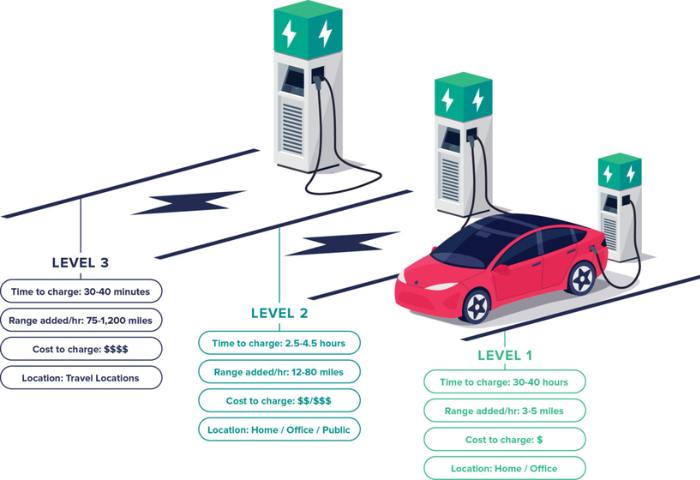
Initial Investment and Installation Costs
Here’s a structured representation of initial investment and installation costs associated with electric vehicle (EV) charging infrastructure:
| Cost Component | Description |
| Charging Equipment | Costs for purchasing EV charging stations, including hardware, cables, connectors, and associated components. |
| Site Preparation | Expenses for site assessment, planning, and preparation, including land acquisition, permits, and zoning fees. |
| Electrical Upgrades | Costs for upgrading electrical infrastructure to support charging stations, including panel upgrades and wiring. |
| Installation Labor | Fees for professional installation services, including electrical work, mounting, and connection to the grid. |
| Network Connectivity | Expenses for internet or cellular connectivity for remote monitoring, management, and firmware updates. |
| Permitting and Regulatory Costs | Fees for obtaining permits, licenses, and regulatory approvals from local authorities and government agencies. |
| Compliance Testing and Certifications | Costs for compliance testing, safety certifications, and regulatory compliance to ensure legal and safety requirements are met. |
| Signage and Branding | Expenses for signage, branding, and marketing materials to promote visibility and accessibility of charging stations. |
| Training and Education | Costs for training staff and personnel on operating, maintaining, and troubleshooting charging infrastructure. |
| Contingency | Reserve funds set aside to cover unexpected costs, contingencies, or unforeseen challenges during installation. |
These initial investment and installation costs are essential considerations for EV charging infrastructure projects, impacting the total cost of ownership (TCO) and the financial viability of charging network deployments. By accurately estimating these costs and implementing cost-effective installation practices, operators can ensure the successful implementation and operation of EV charging infrastructure while maximizing return on investment.
Operational and Maintenance Costs
Here’s a structured representation of operational and maintenance costs associated with electric vehicle (EV) charging infrastructure:
| Cost Category | Description |
| Electricity Costs | Expenses for purchasing electricity to power charging stations, typically calculated per kWh consumed. |
| Network Connectivity | Costs related to internet or cellular connectivity for remote monitoring, management, and updates. |
| Software Subscription | Fees for software platforms used for charging station management, billing, and user authentication. |
| Maintenance Contracts | Service agreements with equipment manufacturers or third-party providers for regular maintenance. |
| Equipment Upgrades | Costs for upgrading charging station hardware, software, or firmware to improve performance or add new features. |
| Repair and Replacement | Expenses for repairing or replacing damaged or faulty components, including cables, connectors, and charging units. |
| Site Lease or Rent | Rental fees for leasing the land or property where charging stations are installed. |
| Insurance Premiums | Costs for insuring charging infrastructure against damages, liability claims, and equipment failures. |
| Customer Support | Expenses associated with providing customer support services, including helpdesk support and troubleshooting. |
| Compliance and Testing | Fees for compliance testing, certifications, and regulatory compliance to ensure safety and legality. |
| Utilities and Services | Charges for utilities such as water, sewer, and waste management, as well as cleaning and janitorial services. |
| Training and Education | Costs for training staff and personnel on operating, maintaining, and troubleshooting charging infrastructure. |
These operational and maintenance costs are essential considerations for EV charging operators and owners, impacting the total cost of ownership (TCO) and the financial viability of charging infrastructure investments. By carefully managing these costs and implementing efficient maintenance practices, operators can ensure the reliability, safety, and performance of EV charging networks while minimizing operational expenses.
Cost-Benefit Analysis Compared to Other Charging Levels
Comparing the cost-benefit analysis of different EV charging levels involves evaluating factors such as initial investment costs, operational expenses, charging speed, convenience, and overall economic and environmental impact. Here’s a structured representation of the cost-benefit analysis compared to other charging levels:
| Aspect | Level 1 Charging | Level 2 Charging | Level 3 Charging |
| Initial Investment Cost | Low | Moderate to High | High |
| Equipment Cost | Low | Moderate to High | High |
| Installation Cost | Minimal | Moderate to High | High (Infrastructure Intensive) |
| Operational Expenses | Low | Moderate | High |
| Charging Speed | Slow (Typically 3-5 miles of range per hour) | Moderate (Typically 12-25 miles of range per hour) | Fast (Typically 60-100+ miles of range in 20-30 minutes) |
| Convenience | Limited flexibility, suitable for overnight charging at home | More flexibility, suitable for home and workplace charging | High-speed charging, suitable for long-distance travel and quick top-ups |
| Total Cost of Ownership (TCO) | Low | Moderate to High | Moderate to High |
| Environmental Impact | Minimal | Moderate | Moderate to High |
| Grid Impact | Low | Moderate | Moderate to High |
| User Satisfaction | Basic | Good | High |
This analysis highlights the trade-offs between different charging levels in terms of cost, convenience, charging speed, environmental impact, and user satisfaction. While Level 1 charging may offer lower initial investment costs and minimal operational expenses, it provides slower charging speeds and limited flexibility. On the other hand, Level 3 charging offers high-speed charging and convenience for long-distance travel but involves higher initial investment costs and greater environmental and grid impact. Level 2 charging strikes a balance between cost, convenience, and charging speed, making it suitable for a wide range of applications, including home, workplace, and public charging. Ultimately, the choice of charging level depends on individual preferences, usage patterns, and infrastructure availability.
Grants, Incentives, and Subsidies
Grants, incentives, and subsidies are crucial policy tools used by governments to stimulate electric vehicle (EV) adoption and support the deployment of EV charging infrastructure. Here’s a structured representation of grants, incentives, and subsidies related to EVs and charging infrastructure:
| Program | Description |
| EV Purchase Incentives | Financial incentives for consumers, including purchase rebates, tax credits, reduced registration fees, and exemptions from sales tax. |
| Charging Station Rebate Programs | Rebates or grants for businesses, homeowners, and municipalities to install EV charging stations, covering a portion of the installation costs. |
| Infrastructure Funding Programs | Government funding programs and grants for the deployment of public EV charging infrastructure, including fast chargers and level 2 stations. |
| Workplace Charging Incentives | Incentives for employers to install EV charging stations at workplaces, including tax credits, grants, and technical assistance programs. |
| Utility Rate Incentives | Special electricity rates, tariffs, and time-of-use pricing plans for EV owners, offering lower rates for off-peak charging and EV-friendly tariffs. |
| Fleet Electrification Grants and Rebates | Grants, rebates, and incentives for businesses, government agencies, and fleet operators to electrify their vehicle fleets with EVs. |
| Public Sector EV Adoption Programs | Programs to encourage public sector agencies, such as municipalities and transit authorities, to transition their fleets to electric vehicles. |
| Research and Development Grants | Funding for research, development, and innovation in EV technology, battery technology, charging infrastructure, and related areas. |
| Incentives for Low-Income Communities | Targeted incentives and subsidies for low-income individuals and communities to purchase EVs or access EV charging infrastructure. |
| ZEV Mandate Compliance Credits | Tradable credits or incentives for automakers to comply with Zero Emission Vehicle (ZEV) mandates and sell a certain percentage of EVs. |
These grants, incentives, and subsidies provide financial support, reduce upfront costs, and create incentives for consumers, businesses, and government agencies to invest in electric vehicles and charging infrastructure, accelerating the transition to sustainable transportation systems.
Regulatory and Policy Framework
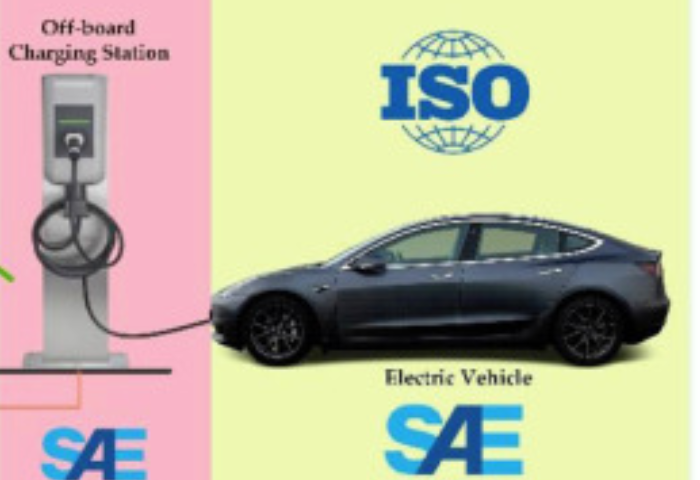
National and International Standards
National and international standards play a crucial role in ensuring interoperability, safety, and reliability in electric vehicle (EV) charging infrastructure. Here’s a structured representation of national and international standards related to EV charging:
| Standard | Description |
| CHAdeMO | Developed by the CHAdeMO Association, providing a standardized protocol for DC fast charging interoperability. |
| Combined Charging System (CCS) | Developed by European and North American automakers, combining AC and DC charging into a single plug and protocol. |
| IEC 61851 | International standard defining charging modes, communication protocols, and safety requirements for EV charging. |
| ISO/IEC 15118 | Standard for vehicle-to-grid (V2G) communication, enabling bi-directional communication between EVs and the grid. |
| SAE J1772 | North American standard for AC charging connectors and communication protocols, commonly used for Level 1 and Level 2 charging. |
| DIN 70121 | German standard for electric vehicle charging infrastructure, covering safety, communication, and interoperability aspects. |
| GB/T (Guobiao) | Chinese standard for EV charging connectors and communication protocols, adopted for DC fast charging interoperability. |
| UL Standards | Set of safety standards developed by Underwriters Laboratories (UL) for EV charging equipment, ensuring compliance with safety requirements. |
| IEEE Standards | Institute of Electrical and Electronics Engineers (IEEE) standards for EV charging infrastructure, covering communication protocols, grid integration, and interoperability. |
| IEC 62196 (Type 2) | International standard for AC charging connectors, commonly used in Europe and other regions for Level 2 charging. |
These national and international standards ensure compatibility, safety, and reliability in EV charging infrastructure, facilitating seamless interoperability and promoting the widespread adoption of electric vehicles worldwide.
Government Policies and Regulations
Government policies and regulations play a crucial role in shaping the landscape of electric vehicle (EV) adoption and charging infrastructure development. Here’s a structured representation of government policies and regulations related to EVs and charging infrastructure:
| Policy/Regulation | Description |
| Vehicle Emissions Standards | Mandates for reducing greenhouse gas emissions and promoting cleaner vehicles, including zero-emission vehicle (ZEV) mandates. |
| EV Incentives and Subsidies | Financial incentives, tax credits, rebates, grants, and subsidies for EV purchases, charging infrastructure deployment, and research. |
| EV Purchase Incentives | Direct incentives for consumers, such as purchase rebates, tax credits, reduced registration fees, and exemptions from sales tax. |
| Charging Infrastructure Funding | Government funding programs, grants, and subsidies for the deployment of EV charging infrastructure, including public charging networks. |
| Zero-Emission Vehicle (ZEV) Mandates | Regulations requiring automakers to produce and sell a certain percentage of zero-emission vehicles, stimulating EV market growth. |
| Emissions Reduction Targets | Government targets and commitments for reducing transportation-related emissions, with EV adoption as a key strategy. |
| Infrastructure Investment Programs | Government investments in EV charging infrastructure, grid upgrades, and smart city initiatives to support electrification efforts. |
| Workplace Charging Mandates | Requirements for employers to provide EV charging stations at workplaces, promoting EV adoption among employees. |
| Public Sector Fleet Electrification Goals | Goals and targets for transitioning government fleets to electric vehicles, demonstrating leadership in sustainable transportation. |
| Charging Station Standards and Regulations | Standards and regulations governing the installation, operation, and safety of EV charging stations, ensuring reliability and safety. |
| Utility Regulations and Grid Integration | Regulations governing utility engagement, grid connection requirements, demand management, and rate structures for EV charging. |
These government policies and regulations create incentives, mandates, and frameworks to accelerate EV adoption, expand charging infrastructure, reduce emissions, and facilitate the transition to sustainable transportation systems.
Compliance and Legal Requirements
Here’s a structured representation of compliance and legal requirements related to electric vehicle (EV) charging infrastructure in a table format:
| Requirement | Description |
| Safety Standards | Compliance with safety standards such as UL (Underwriters Laboratories), IEC (International Electrotechnical Commission), and local regulations. |
| Electrical Codes and Regulations | Adherence to national and local electrical codes and regulations governing installation, wiring, grounding, and safety practices. |
| Accessibility Standards | Compliance with accessibility standards, including ADA (Americans with Disabilities Act), ensuring charging stations are accessible to all users. |
| Environmental Regulations | Compliance with environmental regulations related to battery disposal, hazardous materials handling, and environmental impact assessments. |
| Data Privacy and Security Regulations | Adherence to data privacy laws and regulations governing the collection, storage, and protection of user data and charging transaction information. |
| Interoperability Standards | Adoption of interoperability standards, protocols, and communication interfaces to ensure compatibility and seamless integration with different EV models. |
| Permitting and Zoning Requirements | Obtaining permits and approvals from local authorities for installation, construction, and operation of charging infrastructure in compliance with zoning laws. |
| Grid Connection and Utility Regulations | Compliance with utility regulations, grid connection requirements, demand management programs, and tariff structures for EV charging. |
| Payment Processing Regulations | Adherence to financial regulations and payment processing standards governing transactions, billing, invoicing, and taxation for charging services. |
| Liability and Insurance Requirements | Ensuring liability coverage, insurance policies, and indemnification agreements to address potential risks, accidents, and liabilities associated with charging stations. |
This table provides an overview of compliance and legal requirements relevant to EV charging infrastructure, encompassing safety standards, electrical codes, accessibility regulations, environmental requirements, data privacy laws, interoperability standards, permitting and zoning regulations, grid connection rules, payment processing standards, and liability insurance considerations.
Impact of Regulations on Market Growth
| Aspect | Positive Impact | Negative Impact |
| Certainty and Stability | Provides certainty and stability for investors and stakeholders | Uncertainty or frequent changes hinder investment and deployment |
| Market Competition | Fosters competition, innovation, and market entry | Restricts competition, favors incumbents, stifles innovation |
| Market Expansion | Stimulates investment, reduces barriers, accelerates growth | Increases costs, delays, bureaucratic hurdles |
| Innovation and Technology Adoption | Drives innovation, sets standards, promotes technology adoption | Hinders innovation, rigid standards, slows technology adoption |
| Consumer Confidence | Enhances trust, credibility, and adoption of EV charging | Erodes trust, safety concerns, fraudulent practices |
| Environmental and Energy Policy Goals | Promotes sustainability, supports energy transition | Misses targets, ineffective policies, undermines objectives |
This table outlines how regulations can have both positive and negative impacts on various aspects of market growth in the electric vehicle charging sector.
User Experience and Adoption
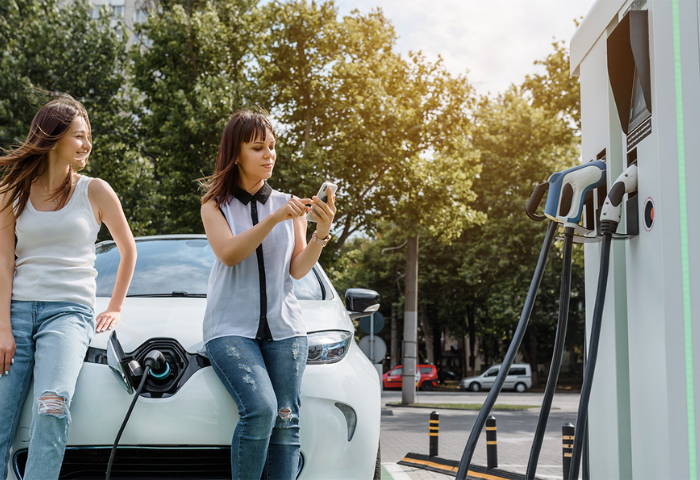
Consumer Awareness and Education
| Aspect | Description |
| Understanding EV Technology | Educating consumers about the benefits of EVs, dispelling myths about range limitations, and highlighting the performance advantages of electric vehicles. |
| Charging Infrastructure Options | Informing consumers about various charging options, including home charging, public charging networks, workplace charging, and fast charging stations. |
| Charging Behavior and Best Practices | Providing guidance on proper charging etiquette, efficient charging practices, and maximizing the use of charging infrastructure resources. |
| Financial Incentives and Cost Savings | Educating consumers about available incentives, tax credits, rebates, and potential cost savings associated with EV ownership and charging infrastructure. |
| Environmental and Social Impact | Raising awareness about the environmental benefits of EVs, such as reducing emissions and improving air quality, and their social impact on communities. |
| EV Ownership Experience | Offering opportunities for consumers to test drive EVs, attend EV experience events, and access user-friendly resources for navigating the EV ownership journey. |
| Accessibility and Inclusivity | Addressing barriers to EV adoption, such as accessibility issues, language barriers, and awareness gaps among underserved communities. |
This table outlines various aspects of consumer awareness and education efforts aimed at promoting the adoption of electric vehicles and understanding EV charging infrastructure options.
Charging Station Accessibility and Coverage
| Aspect | Description |
| Accessibility for All Users | Ensuring compliance with ADA requirements and universal design principles to accommodate users with disabilities. |
| Geographical Coverage | Deploying charging stations in urban, suburban, and rural areas to provide convenient access for residents, commuters, and travelers. |
| Charging Station Density | Installing charging stations in high-density areas, along transportation corridors, and at destination locations to meet demand. |
| Network Interoperability | Facilitating roaming agreements and interoperable standards to ensure seamless access to charging infrastructure across networks. |
| Public and Private Partnerships | Collaborating with government agencies, utilities, and private stakeholders to expand charging infrastructure through investments. |
| Smart Charging Solutions | Implementing demand-based deployment, smart grid integration, and data-driven solutions to optimize charging infrastructure usage. |
This table provides an overview of various aspects of charging station accessibility and coverage, highlighting efforts to enhance accessibility, expand geographical coverage, increase charging station density, promote interoperability, foster partnerships, and implement smart charging solutions in the electric vehicle charging infrastructure ecosystem.
Impact on EV Adoption Rates
Here’s a structured representation of the impact of charging station accessibility and coverage on EV adoption rates in a table format:
| Aspect | Impact on EV Adoption Rates |
| Range Confidence | Increased accessibility alleviates range anxiety, boosting adoption. Limited availability may deter potential buyers. |
| Convenience and Accessibility | Expanded coverage makes EV ownership more practical and appealing. Limited accessibility may inconvenience potential buyers. |
| Market Penetration | Robust charging networks facilitate effective marketing and drive higher adoption rates. Limited coverage may hinder market penetration. |
| Consumer Confidence | Accessibility enhances confidence in EVs as viable alternatives. Limited coverage may erode confidence and deter buyers. |
| Policy Support | Supportive policies accelerate adoption rates by promoting charging infrastructure expansion. Lack of support may impede market growth. |
This table summarizes the impact of charging station accessibility and coverage on EV adoption rates, highlighting the positive and negative effects of accessibility and coverage on various aspects of EV market growth.
User Feedback and Satisfaction
| Aspect | Description |
| Improving User Experience | Incorporating positive feedback to enhance accessibility, reliability, ease of use, and user interface design. |
| Enhancing Service Quality | Monitoring user satisfaction metrics for quality assurance and continuous improvement of charging infrastructure operations. |
| Building Trust and Loyalty | Engaging with users, providing transparent information, and fostering positive relationships to build trust and customer loyalty. |
| Tailoring Services to User Needs | Designing user-centric solutions and customizing services based on user behaviors, preferences, and feedback. |
| Measuring Success and Impact | Tracking user satisfaction metrics and performance indicators to evaluate the success and impact of charging infrastructure investments. |
This table outlines various aspects of user feedback and satisfaction, highlighting efforts to improve user experience, enhance service quality, build trust and loyalty, tailor services to user needs, and measure the success and impact of charging infrastructure investments.
Market Trends and Future Outlook
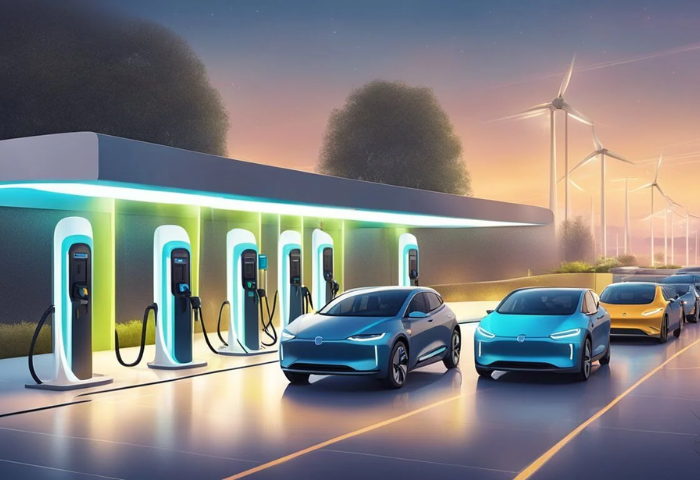
Emerging Technologies and Innovations
| Technology | Description |
| Ultra-Fast Charging | High-power charging, 800-volt architecture, liquid-cooled cables, solid-state batteries |
| Wireless Charging | Inductive charging, dynamic wireless charging on roadways, charging pads embedded in the ground |
| Vehicle-to-Grid (V2G) Integration | Bidirectional charging, grid services, frequency regulation, demand response |
| Blockchain and Smart Contracts | Secure and transparent transactions, decentralized networks, peer-to-peer energy trading |
| Artificial Intelligence (AI) and Predictive Analytics | Charging optimization, predictive maintenance, real-time data analysis |
| Energy Storage Integration | On-site storage solutions, lithium-ion batteries, flow batteries, vehicle-integrated storage |
This table provides an overview of emerging technologies and innovations shaping the evolution of EV charging infrastructure, including ultra-fast charging, wireless charging, vehicle-to-grid integration, blockchain and smart contracts, AI and predictive analytics, and energy storage integration.
Market Growth and Demand Forecast
Here’s a structured representation of market growth and demand forecast for electric vehicle (EV) charging infrastructure in a table format:
| Factor | Description |
| Technological Advancements | Ultra-fast charging, wireless charging, smart charging solutions, solid-state batteries |
| Government Policies and Incentives | Regulatory mandates, financial incentives, infrastructure investment programs |
| Consumer Demand and Adoption Trends | Increasing EV sales, range anxiety mitigation, convenience and accessibility of charging infrastructure |
| Industry Dynamics and Competition | Market competition, partnerships and collaborations, global expansion of EV markets |
| Technology Adoption and Market Trends | Emerging markets, energy transition, integration with renewable energy sources |
| Market Forecast | Growth projections, regional variations, market maturity |
This table outlines various factors influencing the market growth and demand forecast for EV charging infrastructure, including technological advancements, government policies, consumer demand, industry dynamics, technology adoption, and market trends.
Challenges and Barriers to Adoption
| Category | Challenges and Barriers |
| Infrastructure Deployment | High upfront costs, zoning and permitting complexities, limited grid capacity |
| Range Anxiety and Infrastructure Gaps | Concerns about EV range, interoperability issues, charging infrastructure gaps |
| Consumer Education and Awareness | Lack of awareness, misconceptions about EVs, charging infrastructure options |
| Regulatory and Policy Uncertainty | Policy fragmentation, lack of incentives, regulatory uncertainty |
| Technical and Operational Challenges | Charging speed limitations, reliability issues, maintenance requirements |
| Equity and Access | Socioeconomic disparities, unequal access, digital divide |
This table outlines various challenges and barriers to the adoption of EV charging infrastructure, highlighting factors such as infrastructure deployment, range anxiety, consumer education, regulatory uncertainty, technical challenges, and equity considerations. Addressing these challenges requires collaborative efforts from stakeholders across sectors to overcome barriers and promote the widespread adoption of electric mobility.
Future of Mobility and Electric Vehicles
Here’s a structured representation of the future of mobility and electric vehicles (EVs) in a table format:
| Aspect | Description |
| Rapid EV Adoption | Increasing consumer awareness, declining battery costs, and government incentives driving rapid adoption of EVs. |
| Expansion of EV Models | Automakers investing in an expanding range of EV models across various vehicle segments, including passenger cars, SUVs, trucks, and commercial vehicles. |
| Battery Technology Advancements | Continued advancements in battery technology, such as solid-state batteries and increased energy density, improving EV range, charging times, and performance. |
| Integration of Mobility Services | Rise of mobility-as-a-service (MaaS) platforms integrating various transportation modes, offering seamless and sustainable mobility solutions. |
| Autonomous Vehicles (AVs) | Development of autonomous driving technology revolutionizing mobility, improving safety, efficiency, and accessibility. |
| Smart Infrastructure | Implementation of smart city infrastructure solutions optimizing mobility, reducing congestion, and enhancing sustainability. |
| Emissions Reductions | Widespread adoption of EVs playing a crucial role in reducing greenhouse gas emissions, improving air quality, and mitigating climate change. |
| Circular Economy | EV manufacturers focusing on sustainability throughout the product lifecycle, contributing to the development of a circular economy for EVs. |
| Carbon Neutrality Goals | Governments, companies, and cities setting ambitious carbon neutrality targets, with EVs playing a central role in achieving these goals. |
| Charging Infrastructure Expansion | Investments in the expansion of EV charging infrastructure, including fast chargers, ultra-fast chargers, and charging networks, to support growing EV adoption rates. |
| Regulatory Frameworks | Implementation of regulatory initiatives, such as emissions standards, vehicle electrification mandates, and zero-emission zones, driving EV adoption and shaping sustainable mobility. |
| Financial Incentives | Provision of financial incentives, tax credits, rebates, and subsidies for EV purchases, charging infrastructure deployment, and renewable energy adoption accelerating the transition to electric mobility. |
This table provides an overview of key aspects shaping the future of mobility and electric vehicles, including EV adoption, technological advancements, integration of mobility services, sustainability initiatives, infrastructure development, regulatory frameworks, and financial incentives.
Case Studies and Real-World Applications
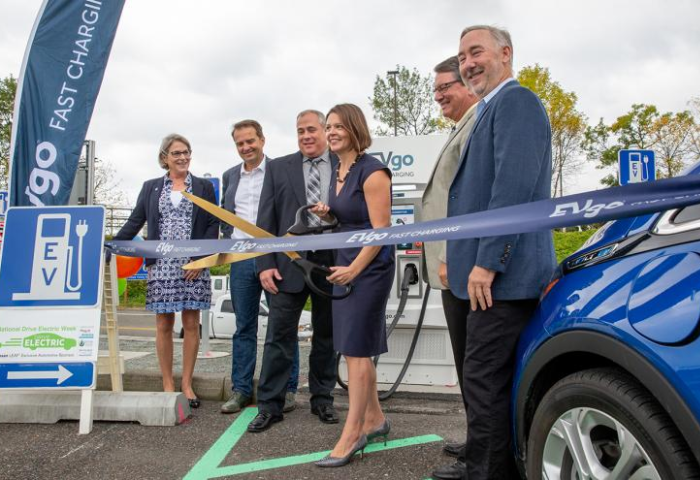
Successful Deployments and Projects
Here’s a structured representation of successful deployments and projects in electric vehicle (EV) charging infrastructure in table format:
| Project | Description |
| Tesla Supercharger Network | A network of high-speed charging stations deployed by Tesla, offering convenient access to EV charging along major travel routes. |
| Ionity High-Power Charging Network | A joint venture by major automakers to deploy high-power charging stations across Europe, enabling ultra-fast charging for EVs. |
| Electrify America Initiative | A comprehensive EV charging infrastructure project funded by Volkswagen as part of its emissions settlement, focused on expanding fast charging across the United States. |
| EVgo Fast Charging Network | A leading provider of fast charging solutions in the United States, with a network of DC fast chargers strategically located in urban areas, along highways, and in key destinations. |
| ChargePoint Charging Network | One of the largest EV charging networks globally, offering a comprehensive portfolio of charging solutions for businesses, fleets, and drivers. |
This table highlights successful deployments and projects in the EV charging infrastructure sector, including initiatives by major automakers, charging network operators, and public-private partnerships.
Partnerships and Collaborations
Partnerships and collaborations are vital for advancing electric vehicle (EV) charging infrastructure and fostering innovation in the electric mobility ecosystem.
| Partnerships and Collaborations | Description |
| EV Manufacturer – Charging Network Operator Collaboration | Collaboration between EV manufacturers and charging network operators to provide integrated charging solutions, enhance user experience, and expand charging coverage. |
| Utility – Charging Infrastructure Provider Partnership | Partnerships between utilities and charging infrastructure providers to develop smart grid integration solutions, optimize energy management, and support grid-balancing services. |
| Public-Private Partnerships for Infrastructure Deployment | Collaborative efforts between government agencies, private companies, and non-profit organizations to fund, deploy, and operate public EV charging infrastructure projects. |
| Cross-Industry Alliances for Standardization and Interoperability | Alliances and consortiums formed by automotive OEMs, charging equipment manufacturers, and industry stakeholders to develop interoperable standards and protocols for EV charging. |
| Research Institutions – Industry Collaboration for Technological Innovation | Collaborative research and development projects between academic institutions, research organizations, and industry partners to advance EV charging technology, battery technology, and energy storage solutions. |
| Automaker – Energy Company Collaboration | Partnerships between automakers and energy companies to offer integrated energy solutions, vehicle-to-grid (V2G) services, and renewable energy-powered charging options for EV owners. |
These partnerships and collaborations facilitate knowledge sharing, technology development, market expansion, and infrastructure deployment, driving the growth and evolution of EV charging infrastructure worldwide.
Business Models and
Business Models and Monetization Strategies are essential components of the electric vehicle (EV) charging infrastructure ecosystem, enabling operators to sustainably deploy and operate charging stations while providing value to customers. Here’s a structured representation in a table format:
| Business Model | Description |
| Pay-per-Use | Charging operators charge EV drivers based on the amount of electricity consumed during charging sessions. |
| Subscription Services | Subscription-based models offer EV drivers access to charging networks for a monthly or annual fee, often with unlimited charging or discounted rates. |
| Membership Programs | Membership programs provide exclusive benefits, perks, and discounts to EV drivers who join charging networks or loyalty programs. |
| Ad-Supported Charging | Charging operators monetize charging stations through advertising placements, sponsorships, and partnerships with brands. |
| Demand Response Services | Charging operators offer grid-balancing and demand response services, leveraging EV batteries to support grid stability and earn revenue from utilities. |
| Value-Added Services | Charging operators offer value-added services such as valet charging, concierge services, or vehicle maintenance while charging. |
| Data Monetization | Charging operators leverage charging data to provide analytics, insights, and targeted marketing services to partners and stakeholders. |
| Energy Sales and Ancillary Services | Charging operators generate revenue by selling excess energy, providing energy storage services, or offering vehicle-to-grid (V2G) capabilities. |
| Infrastructure as a Service (IaaS) | Charging operators provide turnkey solutions, including hardware, software, installation, and maintenance, to property owners or businesses. |
These business models and monetization strategies enable charging operators to generate revenue, cover operational costs, and achieve profitability while meeting the growing demand for EV charging infrastructure.
Mobile Level 3 EV chargers offer a versatile and effective solution for providing rapid charging capabilities to EVs in diverse locations, contributing to the expansion and accessibility of EV charging infrastructure while supporting sustainable mobility initiatives.

Henry Michael is a leading expert in EV charging station research, specializing in innovative solutions for electric vehicle infrastructure. With a passion for sustainability and technological advancement, he is dedicated to advancing the accessibility and efficiency of EV charging worldwide.

